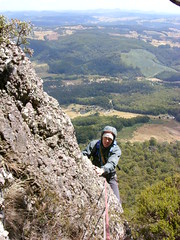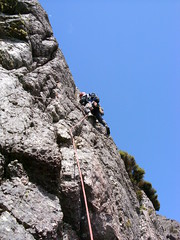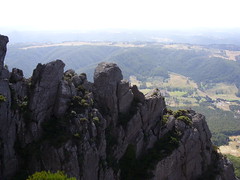
By Rod Smith
It was near midnight when we knocked on the door of Stephen Brown's house at the foot of Mt Roland, in North-West Tasmania.
As buggered as we were from the long day, Rick Fielding and I were keen to share a celebratory drink with the bloke who'd put up the route we'd just been climbing for nine hours.
Shaking off sleep as he answered the door, Stephen ushered us inside, proffering beer and soft seats to collapse into.
As the beer, to quote Henry Lawson, made us feel the way you ought to feel without beer, we talked about the 350m route that Stephen and some mates had established just over 30 years before on Rysavy Ridge.
We’d introduced ourselves to him that morning on the way up the hill. Discussing the weather, which was cold and windy, Brown had concluded “You’re set like jelly,”. A comment that ensured that conditions that we considered possibly too cold, suddenly became ideal.
Brown said he’d been monitoring our progress through his binoculars.
"You didn't go the easy way, I'll tell you that,'' he said.
“I’ve been that way myself and it isn’t 11 or 12 or whatever grade they’ve given Rysavy.”
We knew that much. As Rick had grunted his way up the steep pitch 4 and I’d tip-toed my way up the delicate, cracked face of the 60m pitch 5, we were fully aware that we were technically off route.
The Rysavy Ridge route description is spare and simply says: “the climb is fairly straight forward, generally following the line of least resistance up the ridge … ”.
For the first three pitches we found that the line of least resistance meant keeping to the left.

Our decision to not keep left happened after we had a near-synchronised need to take a crap half-way through pitch 4. After we returned to the hastily discarded gear, from opposite ends of the big ledge, we examined where the next pitch went, and felt uninspired. Then we examined the wall to the right.
That pitch and the next, arguably, pumped the grade of the route to up around the grade 17+ mark but in doing so provided the best climbing of the day. At the time we even thought we might be onsighting some new variant pitches. It was not to be.
After “line of least resistance up the ridge” the rest of the Rysavy route description says: “ … unless you want to make your own, harder variation (which many have, sometimes inadvertently)”. Then Stephen confirmed he’d been there before.
We'd begun the route at 8.30am. Despite being early February and technically summer, it was cold and windy enough for us to climb in thermals and windshells. As I led up into the unknown, buffeted by the strong winds, I had a knot in my stomach: situation normal for me on multi-pitch routes.
I ran the first pitch out the full 60m of our double ropes – as we’d decided we would do where possible – before bringing Rick up.
Pitch 2 added a bit of spice as it wandered upwards to a head wall cracked by an off-width. I shivered as Rick made his way up through a fairly mixed pitch before tackling the short off-width. Settled on a big ledge, he quickly brought me to the top.
It was at this time that our friends John and Marian Shaw decided to call off their climb of the ridge. Starting behind us, Marian had led the first pitch only to slip on the damp lichen. Scraped and cold, the pair set up a windbreak and tried to warm up before deciding that retreat was the better part of valour.
Rick and I felt bad for the Shaws who were very keen to do the route. John, however, decided that there was still plenty to be done and for the next 10 hours acted as a sort of base camp, calling us up on our walkie-talkies and checking our progress. On the walk back to camp, he guided us down the twisting, ankle-breaking track which he’d re-marked, on the way up to meet us, with reflective tape.
But before we could be guided down we had to climb the thing...
Pitch 3 was broken into two: the first a short pitch to a corner in which I found a fixed wire (which I left). We then moved the belay around the corner on the left side of the ridge to an off-width corner.
After moving up the corner 10m I decided to strike out right onto a overhanging, juggy headwall. Why? I dunno. I blame it on reading three different accounts of the climb which included the words "juggy wall".
Freaked out by a hex that had someone levitated and followed me up the overhang – leaving me gear-free for a considerable way – I decided to head back to the crack. This decision included hanging off a precarious-looking flake with a pebble embedded in the top and ensured that I created one of my best ever Z-drag scenarios, despite the double ropes.
With some difficulty I topped out on a pinnacle in a comfy bower and brought up Rick. As it happened it was also the same place where the overhanging headwall would have topped out, had I stuck to the line.
Rick struck off on the fourth pitch, for about five minutes: that’s how long it took for him to gain the big, shrub-lined, aforementioned ledge where we downed tools for a synchronised bowel movement.
On the ledge were two, small wrist-sized or smaller shrubs with white slings around the bases. It appeared that someone had bailed from the ledge down into the ridge's descent gully. It's the same gully - after three hours of tangled-rope abseils off tiny trees and muddy bum-sliding in the darkness - that I would come to think of a small slice of hell lodged in the Tasmanian wilderness.
Back in character on the ledge – pants on, harnesses cinched – we examined the left-hand side of the ridge for the next part of pitch 4, only to be repelled by the sight of the scrubby corner.
Then the blunt, juggy looking arête on the right caught our eyes. I instantly thought: "It’s Rick’s lead, sucker". Then I thought: "A variant, a variant, ring the bells, let’s steal some history". Rick agreed with the second thought.
It seemed to take ages for him to climb the arête. When it was finally time for me to follow I soon discovered why. Sloping, vertical and not as hold-riddled as it looked, it was a tough pitch.

A rightwards traverse was all that was left between Rick and I, but it was on slopey ground with stuff-all gear and plenty of falling-into-the-abyss potential.
From a distance Rick looked to be seated in a comfy, corner belay. When I got there I found he was belayed in a bottomless corner with no room for me. I momentarily wished we’d taken the less-exciting option above poo ledge.
To begin pitch 5 required a tenuous tip-toe around Rick to gain the wall. That somehow achieved, I eyed the delicate flakes of rock that I were between me and a factor 2 fall. Possibly whimpering, I gingerly scaled the flake before slamming a skin-tearing fist-jam into the lovely crack above. Feeling more secure I looked up and up and up. The pitch appeared to be at least 60m. With our stripped down rack – for luggage weight reasons – I noted that I’d have to be a bit careful with gear.
Another guidebook phrase “delicate cracks” screamed at me as I negotiated the pitch which involved swapping from one crack to the next, ruthlessly ripping out with one hand a small bush, while barely holding on with the other, and banshee-like screaming of the word “below” after accidentally dropping a football-sized brain-bomb Rick’s way.
By the time I topped out there was little rope left and only three pieces with which to make a belay. I was exhilarated, or knackered, I can’t remember which.
Rick wandered up oblivious to the drama I’d undergone for the past hour, in much the same way as I suspect pitch 4 had been for him.

With gear swapped, Rick led off on pitch 6, stretching the rope out the full 60m amid a varied pitch of small buttresses, unprotected mini-overhangs, culminating on a three-point belay on a tiny tea-tree that was clinging miserably to the rock.
Pitch 7 was a long, easy and scrappy affair. It began nicely enough, with another near vertical wall whose cracks provided secure gear placements. After a short portage to the next belay, I brought Rick up to defeat the rope drag. Then I continued the route up a short chimney, before again bringing up Rick. Still calling it pitch 7, I led on up a scrubby ridge just shy of the climb’s highpoint: once again rope drag had dictated the pitch length.
It was Rick’s good fortune to reach the highpoint before leading across the knife-blade ridge that connected our route to the rest of the mountain. With massive drops either side it was a spectacular pitch.
Pitch 9 was mine. After a wider section, the ridge once again returned to a cheval. As I traversed, I noticed just how late it was getting: 7pm by my scratched and nicked watch. This realisation suddenly made me cold and hungry. I stopped and made a belay. Just beyond the ridge narrowed even further: two maddeningly exposed rock steps with massive exposure either side before the ground widened and became the head of the descent gully. It was an easy decision. I radioed Rick: “Mate, I don’t want to do this bit, it’s your pitch”.
Youth came skipping along the ledge, barely stopping to rerack, before nonchalantly negotiating the narrow step and finishing the climb: a nice, even 10th pitch.
I quickly followed Rick and we wandered down to the descent gully. A microwave oven-sized chockstone, festooned with a motley rainbow collection of slings and cord, ominously marked the first abseil.
With darkness now falling I threw our doubles off the chockstone anchor into the even darker gully. Then I rapped off, all the while hoping that the chockstone wouldn’t beat me to the bottom. It held.
For the next three hours we battled darkness, tangled ropes and rap points that were mostly no more than collections of tiny trees lassoed together by tat, to abseil and slide by torchlight back to the base of the climb. From there our most excellent mate John guided us back to Stephen’s hearth.